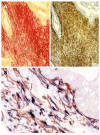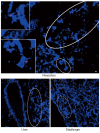Pancreatic cancer and its stroma: a conspiracy theory
- PMID: 25170206
- PMCID: PMC4145760
- DOI: 10.3748/wjg.v20.i32.11216
Pancreatic cancer and its stroma: a conspiracy theory
Abstract
Pancreatic cancer is characterised by a prominent desmoplastic/stromal reaction that has received little attention until recent times. Given that treatments focusing on pancreatic cancer cells alone have failed to significantly improve patient outcome over many decades, research efforts have now moved to understanding the pathophysiology of the stromal reaction and its role in cancer progression. In this regard, our Group was the first to identify the cells (pancreatic stellate cells, PSCs) that produced the collagenous stroma of pancreatic cancer and to demonstrate that these cells interacted closely with cancer cells to facilitate local tumour growth and distant metastasis. Evidence is accumulating to indicate that stromal PSCs may also mediate angiogenesis, immune evasion and the well known resistance of pancreatic cancer to chemotherapy and radiotherapy. This review will summarise current knowledge regarding the critical role of pancreatic stellate cells and the stroma in pancreatic cancer biology and the therapeutic approaches being developed to target the stroma in a bid to improve the outcome of this devastating disease.
Keywords: Metastasis; Pancreatic cancer; Pancreatic stellate cells; Stromal reaction; Tumour-stroma interactions.
Figures





References
-
- Jemal A, Bray F, Center MM, Ferlay J, Ward E, Forman D. Global cancer statistics. CA Cancer J Clin. 2011;61:69–90. - PubMed
-
- Siegel R, Naishadham D, Jemal A. Cancer statistics, 2013. CA Cancer J Clin. 2013;63:11–30. - PubMed
-
- Simard EP, Ward EM, Siegel R, Jemal A. Cancers with increasing incidence trends in the United States: 1999 through 2008. CA Cancer J Clin. 2012:Epub ahead of print. - PubMed
-
- Beger HG. The pancreas: an integrated textbook of basic science, medicine, and surgery. 2nd ed. Oxford: Blackwell Pub; 2008.
Publication types
MeSH terms
Substances
LinkOut - more resources
Full Text Sources
Other Literature Sources
Medical

